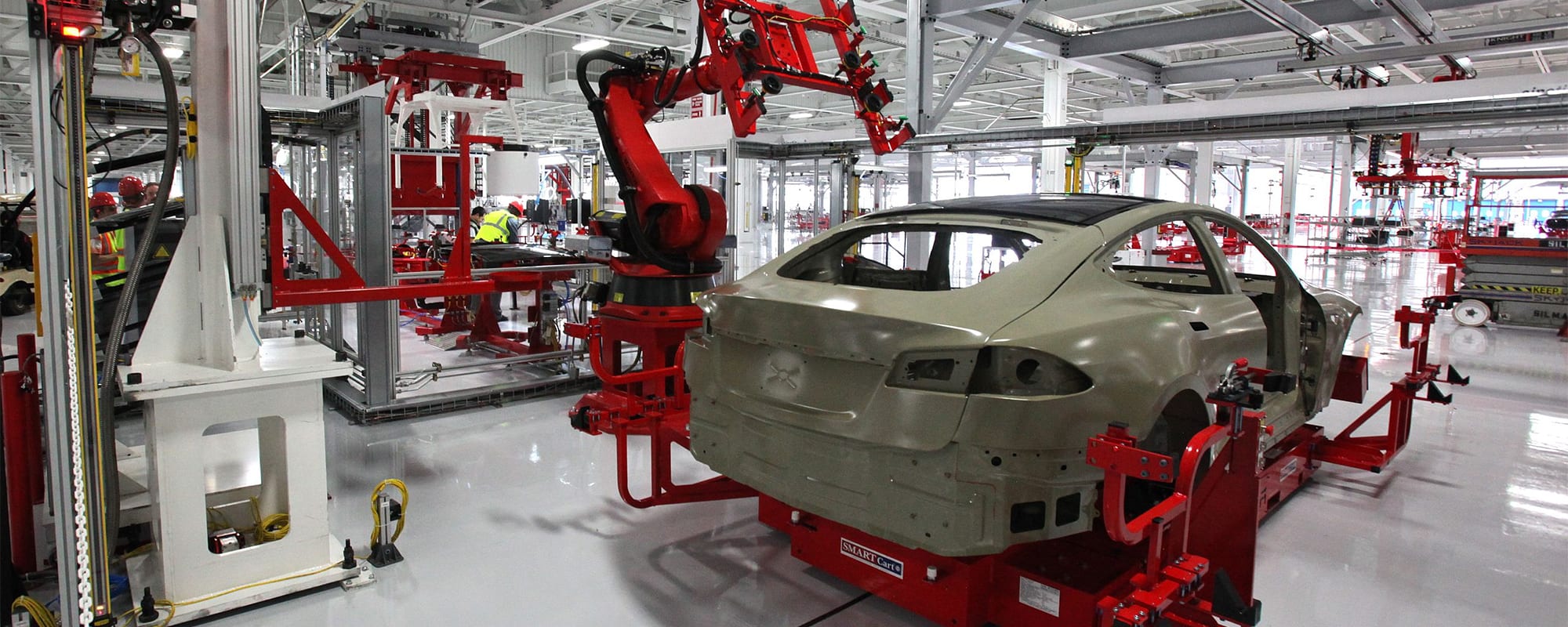Chintan Fafadia, Vice President of Product Management at PCTEL, shares expert insights into Industrial Internet of Things technologies. He introduces key components and characteristics of IIoT technologies, addresses application advantages for multiple industrial markets, dispels misconceptions, shares predictions, and explains how PCTEL provides wireless connectivity customers with a competitive edge.
Chintan Fafadia, Vice President of Product Management, PCTEL

Industry 4.0 technologies are revolutionizing the way that companies in various industries produce and supply goods and services. People often associate Industry 4.0 with the manufacturing industry, and technologies including IIoT networks, cloud computing systems, and AI are making tremendous impacts in this market. But they’re also transforming other industrial markets, including the agricultural, mining, public utility, transportation, and oil & gas industries.
Industry 4.0 technologies are increasingly vital for efficient, effective, safe, and profitable industrial operations, and although they vary widely, the common thread amongst them is connectivity.
For example, Industrial IoT networks comprised of interconnected devices including sensors, software, radios, antennas, and controllers allow manufacturers to gather, transmit, and analyze equipment data, monitor, control, and optimize processes, protect employees and equipment, improve quality and efficiencies, minimize downtime, increase production, and optimize supply chains. They also enable condition monitoring for critical assets in the oil & gas industry, smart metering for public utilities, and enhanced employee and equipment safety in the agriculture, mining, and transportation industries.
To learn more about IIoT technologies, we spoke with Chintan Fafadia, Vice President of Product Management at PCTEL, a leading global supplier of wireless connectivity technologies, including purpose-built IIoT devices, antenna systems, and test & measurement equipment engineered to solve complex challenges and help organizations stay connected, transform, and grow.
Hi Chintan. Please introduce us to PCTEL and tell us a little bit about your career there, like how you came to work there and what you do in your current role. I see that you’ve been with PCTEL for nearly 13 years now and feel like that kind of longevity says a lot about a company, especially given that you’ve worked your way up from your starting role as Product Manager to your current position as Vice President of Product Management.
At PCTEL, wireless is what we do, and connectivity is what we provide and pride ourselves on. We help organizations build efficient and effective communications between people, networks, and devices. Almost 30 years of RF design and development expertise has made us a leader in manufacturing wireless IioT, antenna, and network test & measurement solutions. We started offering IioT connectivity solutions about four years ago, which is where my current role fits in.
I lead our product management team for the IioT devices side of the portfolio. I started at PCTEL in 2010 as a product manager for our scanning receiver products and have since handled multiple tools within PCTEL. I’ve worked on business development and managed products ranging from scanning receivers to data collection software and now our IioT platform. As you said, 13 years says a lot about a company, but I think it says a little bit more about the company’s culture. Our longevity is due to the atmosphere and the people we work with. We work with very sharp people, and it’s always a collaborative culture. It’s all about solving the problems and providing the best value for our customers. We are very customer focused and we always think about how we can leverage our expertise to develop new products that make our customers’ lives easier. That’s one of the many reasons we’re trusted to overcome difficult RF challenges the world over.
Can you provide us with a brief introduction to the IioT?

As consumers, we’re used to the Internet of Things. The IoT encompasses connected technologies designed for both business and pleasure in locations like your house and your car. It’s all about connectivity and combining cellular and Wi-Fi technologies with the different technologies we have for wireless connectivity and a variety of gadgets to make the human experience easier. When you add the other “I” to it, it becomes the Industrial IoT, which applies the same concept of trying to make human life easier to the industrial side of things.
The IIoT is a network of interconnected computing devices embedded in physical objects for the purpose of gathering and exchanging data. The data gathered from these interconnected devices can be used in a variety of ways. It can provide real-time visibility for shipments, predict impending breakdowns of industrial machinery, increase the productivity of the manufacturing workforce, reduce the cost of quality management systems, increase machine utilization, maximize operational efficiency, optimize supply chains, and more.
IioT access points and radio modules provide communication between computing devices and cloud servers to gain insight into systems and processes to enhance and optimize work. The IioT plays a huge role in Industry 4.0 because we need smart manufacturing to improve production and efficiencies, provide safety, and minimize environmental impacts. The IioT brings everything together with the goal of reducing human errors, manual labor, and production costs and increasing overall efficiency.
What benefits does the IioT offer over competing connectivity, control, and communication technologies?
I don’t think it competes; it actually brings everything together. We have so many different connecting technologies and there are so many different standards for those technologies. The IioT allows you to choose the technologies you want and what works the best for you, so you can collect, analyze, and leverage data to achieve benefits ranging from process improvements to preventative maintenance.
Industry 4.0 technologies like the IioT have had an enormous impact on the industrial market in recent years. Do you expect that trend to continue?
Yes. If you look across different verticals and sectors, Industry 4.0 technologies are supposed to grow across multiple verticals at an cumulative average rate of 8–9% based on multiple reports about sensors and the IioT published by Markets and Markets. This estimate covers Industry 4.0 technology growth in all industry verticals, whether you’re talking about agriculture, smart factories, mining, or oil & gas, but several different industries are expected to see IioT technologies grow at a cumulative average rate of at least 5–7% over the next five or six years as well. In fact, the IioT market is predicted to reach $110 billion by 2025.
What are the primary components of an IioT network? If I wanted to deploy an IioT network in my manufacturing facility but wanted to start slow, what would I need and why? What do each of those components do?
To simplify things, there are three main components: the edge component, connectivity, and the data storage and visualization platform. The edge component is your sensor or whatever means of communication you’re using to collect the data. Connectivity is how you transfer the data you’ve collected to a location where you can combine it and analyze it. The third component, which could be a cloud platform or a server, is where the data resides and can be visualized.
To deploy an IioT network, you first need to define the use cases for your manufacturing facilities. What are you trying to achieve? For example, if you want to be alerted when the temperature goes above a certain point in an application, you should select an edge device or sensor to measure the temperature and a method for transferring and storing the collected data. If you’re in a controlled environment, like a factory, you can use Wi-Fi to transfer the data to a specified location. The simplest storage solution for anyone starting out in IioT is to use a cloud platform, which gives you multiple data storage, analysis, and reporting capabilities for less of an investment than local servers.
IioT devices can be categorized into access points, radio modules, antennas, and wireless communication sensors.
- Access Points: IioT access points are designed to provide reliable Wi-Fi connectivity wherever it’s required. With their highly scalable Wi-Fi coverage, these access points deliver enterprise-grade connectivity to devices, even in the harshest environments. High-temperature applications in the manufacturing, utilities, transportation, and agriculture industries require strong, reliable, small, and lightweight IioT access points engineered to ensure high throughput over a wide temperature range. These industrial-grade solutions offer a wider operating temperature range and more rugged enclosures than commercial-grade access points.
- Radio Modules: Radio modules are widely used in applications including edge computing platforms, autonomous vehicles, and robotic cells. These applications typically require rugged, high-power, and small form factor radio modules that are purpose-built to support industrial applications.
- Antennas: Purpose-built antennas designed for industrial applications are the most cost-effective solution for challenging, high-temperature operating environments. Selecting and integrating a suitable antenna has a significant impact on RF subsystem performance in terms of communication range, overall power consumption, and battery life.
- Wireless Communication Sensors: Wireless communication sensors are flexible and cost-effective solutions for improving manufacturing efficiencies. Several sensor types and multiple radio connectivity technology options, such as Bluetooth, cellular, and LPWAN, are available.
Are there any physical or electrical characteristics that new adopters should be sure to look out for and preference as they’re identifying IioT solutions?

It all boils down to your application. If you’re working in an industrial market, like agriculture or construction, you’ll need to make sure that the devices you select can handle temperature extremes and physical hazards like shock and vibration, chemical exposure, and weather, as well as the power levels that you’re able to supply. In a manufacturing facility or a warehouse, your primary need will likely be constant connectivity. So, you’ll need to select the solutions that support the way you communicate using these devices. For example, antennas are a very important part of Industrial Internet of Things solutions, especially when you’re trying to achieve maximum coverage and throughput.
The IIoT is frequently associated with industrial manufacturing applications, but it’s widely employed throughout the industrial market. Can you tell us a little more about how IIoT technology is used in a few different industrial market segments?
The IIoT is used to enhance operations in a wide range of industrial segments, including the precision farming, fleet management, construction, manufacturing, public utilities, and oil & gas markets.
- Precision Farming employs connectivity devices including Wi-Fi routers, cellular and LoRa radios, sensors, GNSS/GPS antennas, and analytics networks to support automation applications likecoverage mapping for precision farming. As more autonomous equipment is being used in the fields, coverage mapping is needed to ensure that equipment is working in sync and not repeating work that has been done, especially since, in the case of spraying pesticides for example, it could be harmful to the crops. Other IIoT-enabled precision farming applications include real-time video streaming, crop monitoring, and machine-to-machine communications.
- Fleet Management employs devices including wired and wireless sensors, GNSS/GPS antennas, combination antennas, and low-profile antennas to improve safety and efficiency.Recent tragedies involving train derailments are one reason that IIoT devices capable of supporting preventative maintenance and monitoring variables such as track temperature, that can contribute to unfortunate events, are gaining a lot of traction in this market.
- Manufacturing employs devices including sensors, industrial access points, custom-engineered antenna solutions, and rugged antennas to improve productivity and enable process automation. For example, sensors are often used to maintain proper temperature ranges when transporting cold or frozen foods. Purpose-built wireless solutions connect teams and devices, make your workforce more efficient, and improve your bottom line, and industrial-grade wireless access points and sensors can help you automate process and quickly identify issues and can deliver data in real time.
The manufacturing segment accounts for about 50% of the total IIoT market in the U.S. The main adoption drivers for IIoT solutions in manufacturing include cost reduction, shorter time to market, and mass customization. Several manufacturing plants are also leveraging the potential of IIoT solutions for condition-based monitoring, asset tracking, and dynamic routing and scheduling.
For instance, automotive, aerospace, chemical, and semiconductor manufacturers are deploying IIoT devices to improve operational efficiencies and overcome manufacturing delays. In these applications, mineral deposits can cause heat exchanger conduits to clog, leading to manufacturing errors and hours of downtime. IIoT devices such as access points and radio modules help overcome these challenges. Threshold values can be defined by measuring and gathering the temperature differentials upstream and downstream of the heat exchanger to establish an alert system that notifies employees when clogging first occurs.


- Utilities employ devices including sensor communication modules, rugged outdoor-rated antennas, and low-profile multiband antennas to reduce outages, automatically detect and anticipate equipment faults, and efficiently manage alternative energy sources in smart metering and smart grid applications based on emerging NB-IoT, LoRa, and LTE-M communications technologies. Smart meters enable automatic meter reading for consumers and companies, automatically alert electricity companies of power outages, and allow utilities and consumers to monitor and analyze consumption and gain critical insights.
- Oil & Gas employs devices including high-power Wi-Fi radio modules and industrial-grade antennas to increase operational intelligence, improve efficiency, and minimize response times in applications including drilling management and pipeline monitoring. For example,pipelines are susceptible to multiple structural failures, such as corrosion, cracks, and leakages. IIoT devices equipped with LPWAN and cellular communication technology, like PCTEL’s wireless communication sensors, can gather granular telemetry data in the field, connect a massive number of geographically dispersed metering points with minimal infrastructure, and provide critical pipeline operating condition and structural health data.
Are there any perceived disadvantages of IIoT technologies that you’d like to dispel? Are there any real but surmountable challenges to adopting these technologies?
The first challenge is always inertia. People get so used to the way they’re used to doing things. So, when you introduce a new technology, it can be a challenge to get people to excited about adoption. People also think that implementing IIoT technologies is very costly, but it’s actually not that costly if you have an optimized solution to make the integration between new and existing infrastructure easier. People need to look at the investment analysis because, in the long run, implementing IoT and IIoT technologies will be beneficial and cost effective for almost every industry.
Does PCTEL’s line of IIoT solutions offer any unique features and benefits that customers won’t find elsewhere?
PCTEL develops innovative, purpose-built wireless equipment engineered to serve enterprise-class IT operations, withstand harsh environments, and maintain continuous connectivity. We design our solutions for the industry we want to serve, so our solutions are superior to commercial-grade components, which can often experience poor connectivity, especially in the presence of interference caused by metal, machinery, or competing wireless signals.
We offer a complete portfolio of rugged, industrial-grade, and purpose-built access points, radio modules, antennas, cabling, and accessories engineered to improve workforce productivity and safety while optimizing cost-effectiveness and meeting or exceeding customer expectations for dependable and efficient wireless solutions. Our RF and mechanical design teams also have the expertise, experience, and insight to support application-specific developments covering all aspects of the IIoT, and we have state-of-the-art in-house antenna design and testing facilities in the U.S. and Asia that we can use to integrate embedded antennas, radio cards, and sensors into your machines and devices and solve specific operational challenges.
For organizations deploying a large variety of antenna applications in a range of different markets around the world, PCTEL offers high-quality purpose-built Wi-Fi, Bluetooth, LMR, TETRA, GNSS, GPS, Cellular, ISM, and LoRa antennas as well as space-saving two-in-one to nine-in-one combination antennas that help increase efficiency and coverage in applications including fleet management, vehicle tracking, and passenger connectivity.
Our services portfolio includes antenna system design for multiple co-located radio configurations, installation and environmental challenge evaluation, electromagnetic (EM) simulation model development, embedded systems design and integration, system-level design verification and analysis, and on platform test and measurement validation.
What do you think is next in terms of IIoT device designs and performance?
I expect more ruggedized form factors, better connectivity, 5G technology, and — as Wi-Fi technologies improve — devices with Wi-Fi 6 and 7 capabilities. I also think we’ll see more deployments over the next few years and, as AI and sensor technologies continue to progress, improved data collection and analysis capabilities that will further reduce downtime, make environments safer, and improve productivity and efficiency.
Is there anything else you’d like industrial OEMs, system integrators, and maintainers to know about the IIoT?
Always begin with your application in mind and work backwards, and find the right partners to work with, because you need people who have the expertise to provide you with the quality products and technical support you need. Gains in efficiency, safety, and security can only be realized if your devices stay connected. So, networking your equipment and devices shouldn’t be left to just any wireless provider. You need a partner whose core focus is rugged wireless radio solutions for mission-critical and business-critical organizations. PCTEL has a proven track record of solving difficult RF problems with our wireless solutions. We understand how to build reliable wireless performance into your IIoT operations and help you transform your enterprise efficiencies. We also have great partners at RS that have the knowledge and experience necessary to help customers identify the solutions they need to start achieving their IIoT goals and provide expert support throughout the implementation and maintenance phases.
Connect, Transform, and Grow Your Business With IIoT Solutions From PCTEL and RS
PCTEL is a leading global supplier of industrial-grade wireless connectivity systems engineered to solve complex challenges and help organizations stay connected, transform, and grow. Solutions including purpose-built IIoT devices, antenna systems, and test & measurement equipment are developed by skilled RF and mechanical design teams with decades of experience, backed by more than 25 years of field-proven quality and reliability, and employed in agricultural, manufacturing, military & defense, mining, public safety, public utility, intelligent transportation, oil & gas, and enterprise wireless applications around the world.
RS offers a wide variety of PCTEL antennas and a growing selection of IIoT devices and works closely with PCTEL to support customers throughout the entire design and development cycle, spanning product selection to implementation and maintenance.
For assistance identifying, deploying, and maintaining PCTEL wireless connectivity solutions engineered to help your organization stay connected, transform, and grow, please contact your local RS representative at 1.866.433.5722 or reach out to the RS technical support team.






